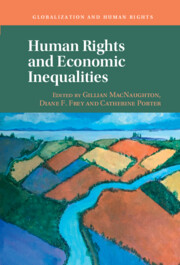Book contents
- Human Rights and Economic Inequalities
- Reviews
- Globalization and Human Rights
- Human Rights and Economic Inequalities
- Copyright page
- Dedication
- Contents
- Figures
- Tables
- Boxes
- Notes on Contributors
- Acknowledgments
- 1 Introduction
- Part I Conceptualizing and Measuring Human Rights and Economic Inequalities
- 2 Emerging Human Rights Norms and Standards on Vertical Inequalities
- 3 Constraints on Economic Inequality: Comparing Canada and the United States
- 4 What the UN Human Rights Treaty Bodies Tell Us about Economic Inequalities and Human Rights: An Empirical Analysis of Twenty Years of Practice
- 5 How Can Economists Help Human Rights Practitioners to Measure Changes in Economic Inequalities?
- Part II Causes and Consequences of Economic Inequalities
- Part III Socioeconomic Rights and Economic Inequalities
- Index
- References
5 - How Can Economists Help Human Rights Practitioners to Measure Changes in Economic Inequalities?
from Part I - Conceptualizing and Measuring Human Rights and Economic Inequalities
Published online by Cambridge University Press: 29 September 2021
- Human Rights and Economic Inequalities
- Reviews
- Globalization and Human Rights
- Human Rights and Economic Inequalities
- Copyright page
- Dedication
- Contents
- Figures
- Tables
- Boxes
- Notes on Contributors
- Acknowledgments
- 1 Introduction
- Part I Conceptualizing and Measuring Human Rights and Economic Inequalities
- 2 Emerging Human Rights Norms and Standards on Vertical Inequalities
- 3 Constraints on Economic Inequality: Comparing Canada and the United States
- 4 What the UN Human Rights Treaty Bodies Tell Us about Economic Inequalities and Human Rights: An Empirical Analysis of Twenty Years of Practice
- 5 How Can Economists Help Human Rights Practitioners to Measure Changes in Economic Inequalities?
- Part II Causes and Consequences of Economic Inequalities
- Part III Socioeconomic Rights and Economic Inequalities
- Index
- References
Summary
This chapter discusses the measurement of economic inequality with the aim of furthering the discussion and potential cooperation between economists and human rights scholars and practitioners. It discusses how to measure economic inequality in the most useful way for the purpose of monitoring progress towards the goal of ensuring dignity and human rights for all. This builds on the work of many other economists (see Atkinson 2015 for a comprehensive review) to seek common ground in understanding the measurement of economic inequality, to be relevant for purposes of policymaking, and discusses new work by economists that improves the measurement of income and wealth, including of the richest. Reddy (2011) argued that economics and human rights approaches can be complementary if sufficient dialogue can be created between the disciplines. In the context of the extreme and growing economic inequalities in the world today, such dialogue has become an urgent matter.
- Type
- Chapter
- Information
- Human Rights and Economic Inequalities , pp. 115 - 140Publisher: Cambridge University PressPrint publication year: 2021



